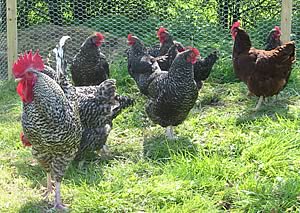 |
|||||||||
|
|||||||||||||||||||
Bird
flu virus could spill over to Africa and Europe in springtime Fighting the disease in animals is crucial to win the battle against
the virus
"FAO is concerned that with trade, the movement of people and animals and migratory birds, new countries could become infected," said FAO Deputy Director-General David Harcharik in his opening speech at the International Pledging Conference on Avian and Human Pandemic Influenza in Bejing, China. "Countries in Africa deserve special attention. In Turkey, the virus has already reached the crossroads of Asia, Europe and Africa, and there is a real risk of further spread. If it were to become rooted in the African countryside, the consequences for a continent already devastated by hunger and poverty could be truly catastrophic," Harcharik said. In endemic areas, the movements of animals, products and people should be controlled. FAO also urged all countries along the routes of migratory birds to be highly vigilant and be prepared for a further spread of the disease in animals. Fighting the virus in animals "Fighting the avian influenza virus in animals is the most effective and cost-effective way to reduce the likelihood of H5N1 mutating or reassorting to cause a human flu pandemic," Harcharik said. "Containing bird flu in domestic animals - mostly chickens and ducks - will significantly reduce the risk to humans. Avian influenza should not only be considered as a human health issue, but as a human and animal health issue." "Such a perception requires close cooperation between health and agricultural and veterinary authorities. Countries that foster close collaboration between the human health and agricultural sectors are likely to be the most successful in battling the disease," Harcharik said. Centrally organised veterinary services are essential for successful bird flu control campaigns. "Governments will fail in combating avian influenza if they don't give their veterinary services the political support as well as the technical and financial means to fight the virus. Early warning systems, swift interventions and preventive measures will remain weak and inadequate without strong, centrally organized veterinary services, " Harcharik said. Improved surveillance and detection will allow farmers and veterinary services to intervene quickly and apply the internationally recommended set of actions, such as culling, biosecurity measures and vaccination. Risky farming practices such as mixing poultry species in farms or in live markets, should be changed as quickly as possible. The impact of these changes on the livelihoods of small farmers should be mitigated. The movements of animals, products and people from endemic areas to other regions should be strictly controlled. "Funding will be needed for compensation schemes for farmers to encourage their participation in control campaigns," Harcharik added. For the global campaign, it is estimated that several hundred million dollars will be needed to combat the disease in animals. FAO plays a major role in this campaign. To date, FAO has received about $28 million from donors, and since the onset of the bird flu crisis in 2003 the agency has spent more than $7 million from its own resources to help affected countries to design bird flu control programmes, supporting surveillance and laboratory diagnostics. Socio-economic studies on the impact of the disease and the cost of control programmes, as well as on options for restructuring, have been carried out. Over the next three years, FAO will require at least $50 million more to continue its support for essential regional and global coordination and cooperation and some $80 million to assist countries to implement their national bird flu control programmes.
|
|||||||||||||||||||

|
|
||||||||||||||||||
| home | agri-services | pedigree
pen | news | dairy | beef | machinery property | organisations | site map |
|||||||||||||||||||

